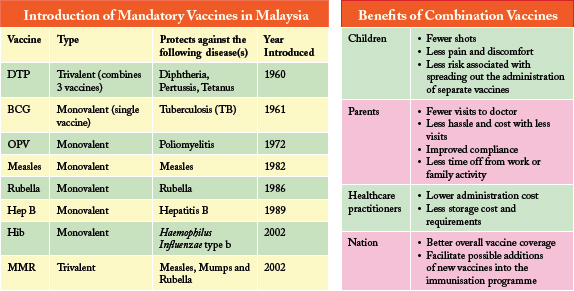Did you know that under our National Immunisation Schedule, your child would have received a total of 16 doses of vaccination by the time he reaches the age of two years? And, most of these doses would have been administered by injection!
Combination vaccines integrate two or more vaccines into a single shot. They are able to prevent multiple diseases all at once with lesser shots than if each vaccine is administered separately. With these vaccines now available, much inconvenience is reduced.
Combination vaccines are not entirely new and have long been in use in our country. Of all the mandatory vaccines under the Malaysian National Immunisation Schedule, six are given in combination. There are 2-in-1 (bivalent), 4-in-1 (tetravalent) and 5-in-1 (pentavalent) vaccines available today. The latest to be introduced is the hexavalent or 6-in-1 vaccine that protects against tetanus, diphtheria, pertussis bacteria, hepatitis B, poliovirus and Haemophilus Influenzae type b, all in one injection.

State of Art
Polio Vaccine
In line with current global trends in polio prevention, new combination vaccines incorporate the inactivated polio vaccine (IPV), which is administered by injection.
Reasons:
- The older oral polio vaccine (OPV) may provoke an immunological response that is similar to natural exposure to the polio virus. This virus causes paralysis.
- OPV will be phased out from our national immunisation programme as we are among the countries where wild polio has been eradicated.
- IPV carries no serious side effects.
- IPV can be used by people with impaired immune systems, autoimmune disease, malignancies and organ transplants.
Pertussis Vaccine
The new Ministry of Health schedule incorporates acellular pertussis (aP) instead of whole cell pertussis (wP) components to prevent whooping cough.
Reasons:
- Acellular vaccine contains less antigens and causes less reaction.
- Both have similar efficacy.
Safe and Sure
Combination vaccines are as safe and effective as individual singledisease vaccines. Many factors need to be looked at before these vaccines can be combined. There cannot be any adverse interaction among the vaccine components, one component should not denature the others, adjuvants used must ensure stability of all components and not react with the vaccines, and the combination should not be more reactogenic than the individual component vaccines. Parents need not worry about the multiple vaccines given at the same time. It has been calculated that the child’s immune cells can handle many more times the antigen found in the combination vaccines.
Speak to your doctor if you are interested in giving fewer shots to your child while giving him maximum protection.







Comments